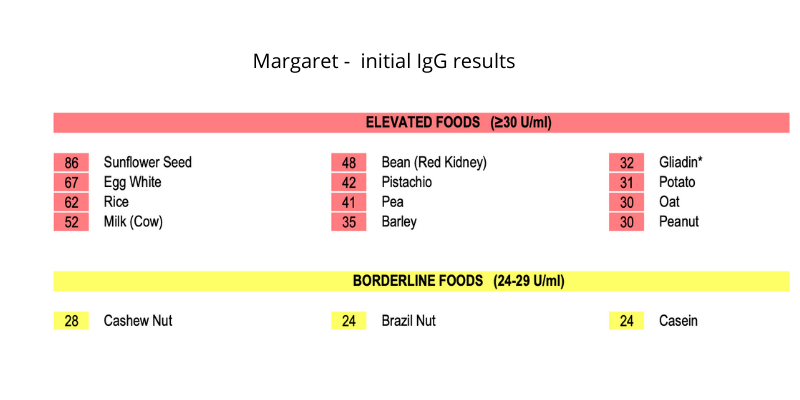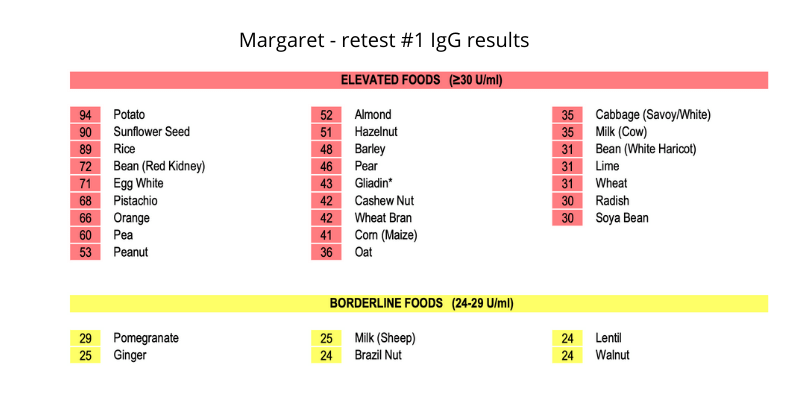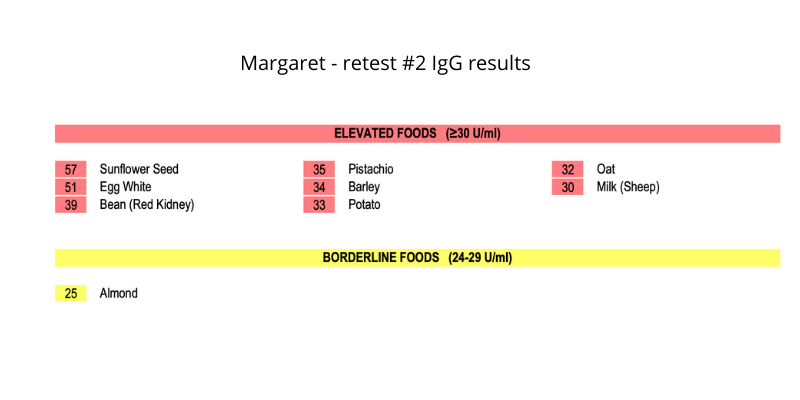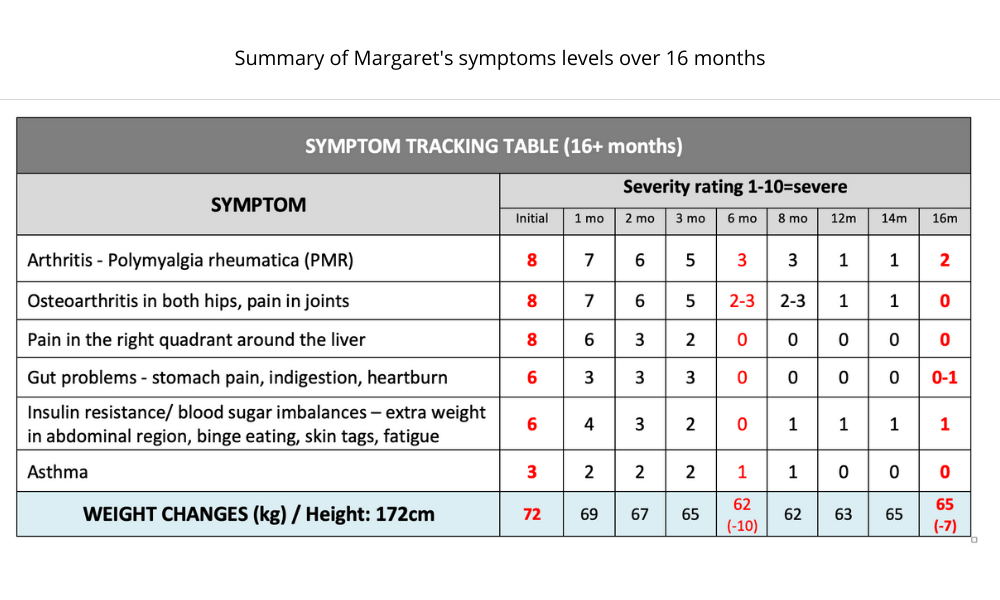Do you suffer from pain, inflammation and arthritis? Have you been looking for solutions and a relief of your symptoms? Read on!
In this post, I discuss a remarkable clinical case of either resolving or improving of a number of significant symptoms and complaints. These included an autoimmune joint disease Polymyalgia rheumatica (PMR), osteoarthritis and significant gut symptoms (including a parasitic infection), after performing the IgG food sensitivities testing and then following the elimination diet based on the test results.
The test utilises an ELISA (enzyme-linked immunosorbant assay) testing [1] for IgG-mediated food sensitivities, and is called IgG FoodPrint® 200+.
To find out more about the testing and methodology used in our clinical study utilising an elimination diet based on food sensitivity testing, click HERE. [2]
Our clinical study to date shows that the elimination is proving to be safe and effective in significantly decreasing gut inflammation (and inflammation throughout the body), reducing pain and arthritic joints pain, and calming down the immune system. These positive changes support and speed up the healing processes in vast majority of our clients involved in the clinical study.
Pain, inflammation, arthritis and food sensitivities – a case study
Clinical case presentation
Margaret, a 62-year-old retiree, presented with a plethora of chronic health complaints. At the time, her main health concerns were:
- PMR (Polymyalgia rheumatica) [3] – an autoimmune inflammatory condition affecting the joints
- Osteoarthritis in both hips and multiple joints
- Gut imbalances – alternating diarrhoea and constipation (‘since forever’), indigestion, reflux (bad for last six months). Dull gut pain after eating lasting around two hours
- Upper right quadrant pain that started after a fall
- Binge eating and sugar cravings – especially chocolate and sweets
- Asthma – long-term, relatively mild (on medication when needed), worse with pollens
- Surgeries: gallbladder removal (2007), 3 inguinal hernias
She was taking multiple medications (including Mobic, Mylanta and Nexium) as well as many supplements – both self-prescribed and/or recommended by her previous naturopath.
She was asked to do basic blood tests to assess nutritional deficiencies and other baseline markers at the start of the elimination diet.
Margaret’s initial IgG food sensitivity test results
Margaret’s initial food sensitivity test results identified a low to moderate number of trigger / inflammatory foods, including two major food groups – gluten and diary
- High sensitivity ‘red’ foods: 12
- Borderline sensitivity ‘yellow’ foods: 3
Main foods/ food groups that needed to be excluded based on the IgG test results were:
- Dairy – all cow milk and products made of it, significantly decrease goat and sheep products
- Gluten – high sensitivity to all gluten containing grains and products made of them
- Eggs – egg whites
- Nuts – peanuts, cashews, Brazil nuts, pistachio
- Other: rice, sunflower seeds (oil), potato, oats
- She also excluded the following: alcohol, coffee, processed sugar and processed foods
See the initial IgG food sensitivities test results below.

Progress timeline
I regularly consulted with Margaret over the 16 months to help her better understand the food restrictions, provide tailored nutrition advice and meal suggestions, and monitor progress. We agreed that she will record detailed food diaries and email them to me before each consultation for analysis and modifications, as needed.
Consultation #2: 1 month after starting the elimination diet
From the start, Margaret excluded all ‘red’ and ‘yellow’ foods and started making modified meals. We reviewed her food diary for the past 4 weeks and discussed improving meal planning, best cooking methods and recipes. She was given relevant nutrition guides to help with meal planning: gluten-, dairy- and egg-free guidelines, as well as breakfast and snack suggestions tailored to her test results.
Her blood test results indicated lower immune system in the gut (i.e. IgA marker) as well as low IgM marker potentially pointing to an active infection or an autoimmune process.
Overall, she reported doing well on the diet so far and experiencing some improvements, especially in joint pain.
Consultation #3: 2 months on the elimination diet
Margaret reported ‘huge improvements’ in the majority of her symptoms – see the summary below. However, she still experienced ‘annoying’ gut symptoms, mainly on/off constipation and cramps. She reported the following changes since the last consultation:
- Pain in the right quadrant significantly decreased – from 8/10 to 3/10
- Indigestion/ reflux – improved from 6/10 to 3/10
- Arthritis, a small improvement – from 8/10 to 6/10
- Gut: on/off constipation and stomach cramps, minimal improvements – 6/10 to 5/10
- Asthma – a small improvement from 3/10 to 2/10
- Weight loss since starting – 3kg (from 72kg to 69kg)
- Less sugar cravings
*Rating scale 1= mild to 10= severe symptoms
She enjoyed cooking the modified meals and actively looked for new recipes on the internet.
Overall, she felt good progress was made so far, except for the on/off constipation and stomach cramps which have not improved by following the diet. We agreed to review the gut symptoms next month and discuss options if they are still the same then.
At this point, she was doing very well and said she enjoyed the life much more now. Pain levels decreased and she was able to get off all pain killers she was taking for arthritis and aching joints.
Consultation #4: 3 months on the elimination diet
Margaret continued to feel good since we spoke last. She Implemented all nutrition recommendations and took the supplements, as agreed. All symptoms, except gut symptoms, were improving. As a gut nutritionist and naturopath, I have special interest and experience in natural treatments for parasitic infections [4], and I suspected Margaret harboured some intestinal parasites. Therefore, we decided for her to do a comprehensive stool test called GI Map [5] to gauge her gut and microbiome health status.
She continued to improve with all symptoms as follows:
- Pain in the right quadrant significantly decreased – from 8/10 to 2/10*
- Less indigestion/ reflux – from 6/10 to 3/10
- Arthritis – a good improvement from 8/10 to 5/10
- Gut: on/off constipation and stomach cramps, minimal improvements – 6/10 to 5/10
- Asthma – a small improvement from 3/10 to 2/10
- Weight loss since starting – 5kg (from 72kg to 67kg)
- Less sugar cravings
*Rating scale 1= mild to 10= severe symptoms
Consultation #5: 5 months on the elimination diet
The stool test identified microbiome imbalances [6], a presence of parasite Dientamoeba fragilis as well as high levels of harmful bacteria, especially Klebsiella that has been linked with autoimmunity and joint pain [7]. The toxins excreted by the parasite and Klebsiella were most likely causing irregular bowel movements and cramps, despite Margaret taking gut support supplements and probiotics.
These results indicated that a natural parasite treatment is indicated to facilitate further gut health improvements. Subsequently, Margaret was prescribed a comprehensive 8–10-week anti-parasitic protocol comprising herbs and gut support supplements as well as diet modifications.
She was also asked to record and rate all gut symptoms during the protocol to be reviewed at the next consultation.
Consultation #6: 6 months on the elimination diet
Margaret reported further good improvements at 6 weeks on the parasite protocol as follows:
- Pain in the right quadrant – completely resolved, severity rating down from 8/10 to 0/10 = severe
- Indigestion/ reflux – completely resolved, severity rating down from 6/10 to 0/10
- Gut: on/off constipation and stomach cramps – all symptoms resolved, severity rating down from 6/10 to 0/10
- Arthritis, joint pain – much improved, pain almost gone, severity rating: down from 8/10 to 2-3/10
- Asthma – almost gone, severity rating down from 3/10 to 1/10
- Sugar cravings – resolved
- Weight loss since starting – 6kg (from 72kg to 63kg)
*Rating scale 1= mild to 10= severe symptoms
She reported feeling more energetic and more mobile without experiencing pain or inflammation. Her nails were strong and healthy, and the skin also improved. She started Pilates classes again and was able to do the exercises without much pain.
We decided to continue with the parasite protocol for the full 10 weeks, and then start the gut repair phase using probiotics and gut/ digestive support supplements and foods.
It should be noted, that taking potent parasite eradication herbs usually leads to some gut lining damage/alteration and microbiome modifications. These need to be rectified by performing a gut and microbiome restoration follow up therapy. This is key to maintain parasite-free (or decreased numbers) internal environment and a more balanced microbiome.
Overall, she made an excellent progress so far and was particularly happy with the improved gut function and pain reduction.
Consultation #7: 8 months on the elimination diet
Margaret was doing well and monitoring her food intake closely. She was recording all food intake between each consultation and sending food journals in before each session. We reviewed them together to identify any nutrition gaps and connect the dots when any symptom got temporarily worse.
She stopped using all painkillers in the past 2 months and managed all symptoms with the diet.
Margaret completed the parasite eradication protocol (for 10 weeks) and was using diet and supplements to repair the gut wall lining, support the liver and keep inflammation down.
Consultation #8: IgG food sensitivities retest results at 8 months on the diet
At this point, Margaret did the repeat IgG test (retest) to gauge which trigger foods were now ‘corrected’ and might be added back. She rated her symptoms as follows:
- Pain in the right quadrant – completely resolved from 8/10 to 0/10 = severe
- Indigestion/ reflux – completely resolved 6/10 to 0/10
- Arthritis, PMR pain – stabilised as before from 8/10 to 2-3/10
- Gut: on/off constipation and stomach cramps – all symptoms gone from 6/10 to 0/10
- Asthma – almost gone from 3/10 to 1/10
- Weight loss since starting – 10kg (from 72kg to 62kg)
*Rating scale 1= mild to 10= severe symptoms
Overall, she was feeling good and no major symptoms were present, except she reported having sugar craving again. Pain, inflammation and arthritis levels were now maintained at a much more comfortable level.
We also discussed removing plastics from the kitchen as well as chemicals and plastics present in personal products she was using.
Quite surprisingly to Margaret, her retest results showed an increase in the number of trigger foods, indicated by more elevated IgG antibody levels. The results were as follows:
- High sensitivity ‘red’ foods: 19 (up from 12 initially)
- Borderline yellow foods: 6 (up from 3 initially)

We had the following scenario to analyse and interpret:
- All symptoms either completely resolved or decreased significantly, however
- IgG antibody levels and a number of ‘elevated’ foods increased indicating higher inflammation levels and more pronounced leaky gut
What were the possible reasons for the IgG antibody levels and a number of inflammatory foods going up on the retest?
The results were not unusual as similar outcomes were also observed in other study participants with chronic health conditions, as outlined in some other case studies [8]. Possible reasons in this case were identified as follows:
1) Margaret’s elimination diet included a comprehensive parasite removal and microbiome rebalancing protocol. Strong anti-parasitic and anti-microbial herbs were used that, although much gentler than antibiotics, likely caused some gut wall damage, temporarily increasing leaky gut and altering/ imbalancing the microbiome.
The protocol worked well and was an important step for Margaret to achieve major improvements in her complaints and symptoms, and thus get good results from following the elimination diet.
Overall, doing the protocol during the elimination diet did likely cause a temporary increase in IgG antibody levels but NOT symptoms. These kept gradually decreasing (with a few small relapses here and there) throughout the whole elimination diet.
2) Important note in relation to IgG mediated food intolerance symptoms, it is essential to understand that it is not the elevated IgG antibodies as such that cause them, but the deposition of antibody-antigen immune complexes within tissues of the body which case inflammation – please read my post HERE for a more detailed explanation [2]. These immune complexes are created when IgG antibodies combine with the food protein antigen(s) for which they were created.
Removing trigger foods leads to a subsequent reduction in the formation of immune complexes and decreases in inflammation levels. We know that it takes time for the IgG antibody levels to subside [9] (between 2-4 months) and retesting too quickly can also be the reason for higher antibody level on retesting.
3) Not adhering to the elimination diet strictly enough and consuming trigger foods (even in small amounts) before the inflammation levels had subsided and the immune system became less reactive. This was the case here.
We agreed that Margaret continued following the elimination diet incorporating the additional trigger foods identified in her retest results for the next six months. She decided to continue our regular consultations and monitoring.
Consultation #9: 12 months on the elimination diet
Margaret reported having good energy levels and sleeping well. Her weight was stable at 63 kg. She was able to exercise more and was doing Pilates and walking.
Margaret described the changes in the following email:
“The great news is, the pain HAS diminished in the upper right quadrant. I am out of the distress I previously experienced. Although scans, gastroscopy, colonoscopy, GP Gastroenterologist couldn’t answer WHY I was in pain, your dietary exclusions based on IgG test seem to have resolved my gut bowel issues.
My weight has stabilised some 10kg under where I started which must assist the whole body. My blood results pass with flying colours according to GP.
My skin is improved and is not as dry.
My aches and pains in shoulders and hips (although still present especially with a lack of movement at night) are no longer constantly present and certainly improved. Only on two occasions in 7 weeks I had to rely on painkiller MOBIC, after being reliant of it to be pain free for PMR.
GP said that the PMR was not present according to inflammatory markers”.
She was still experiencing sugar cravings sometimes, especially after dinner. She continued supplementation with digestive enzymes and probiotics for gut health maintenance, and a few other supplements as directed by her blood test results.
Consultation #10: 14 months on the elimination diet
Margaret reported doing well overall and had no major complaints. There was no negative change to the number of symptoms or their intensity for the past 2 months since our last consultation.
Her weight stabilised at 64-65 kg. She kept off all pain and anti-inflammatory medications. We also reduced a number of supplements she was taking. Her pain, inflammation and arthritis – both PMR and osteoarthritis, were reduced significantly.
At this point, Margaret started re-introducing a few foods including rice, almond and pear. These were well tolerated and she decided to also re-introduce small amounts of spelt to see if there were any reactions.
Consultation #11: second retest (i.e. 3rd food sensitivity test) at 18 months on the elimination diet
Margaret’s second retest results were quite remarkable, indicating significantly decreased inflammation, improved gut wall integrity and better digestive capacities:
- High sensitivity ‘red’ foods: 8 (down from 19 on the 2nd retest)
- Borderline yellow foods: 1 (down from 6 on the 2nd retest)
Importantly, gluten sensitivity was no longer indicated (except for barley). In addition, Margaret could consider re-introducing dairy (cow and goat) but not sheep milk. The other foods that were on the ‘red’ list from the start remained; however, their levels of reactivity were much lower than in the previous tests.
We discussed slow and safe methods of re-introducing a few foods that were now on the ‘green’ list.

Symptom tracking table in chronological order showing Margaret’s progress over 16 months

Summary
Although it was a long journey for Margaret to significantly reduce pain and inflammation, improve her gut function and other complaints, the end result was very satisfying and life changing. The troublesome trifecta of the pain, inflammation and arthritis was settled.
We both agreed that the key factor and a circle breaker in the therapeutic sequence was the use of a microbiome balancing and parasite protocol, when her persisting gut symptoms indicated it, in order to move forward. In fact, having intestinal parasites likely was the main cause of not only her gut symptoms but also her arthritic pain and chronic inflammation.
It’s quite common in my clinical practice to observe a relationship between having parasitic gut infections (and thus microbiome imbalances), and unexplained persistent inflammation, chronic pain, headaches and migraines, anxiety and depression, decreased immune function, among others. Read more about parasitic gut infections and how to rectify them in my detailed article HERE. [4]
Importantly, her autoimmune condition improved dramatically and, on redoing the blood test with her doctor, she was told that ‘PMR was not present according to inflammatory markers tested’.
The other key success factor was Margaret’s commitment to keeping detailed food diaries for the duration of the elimination diet. It allowed us to have great insights into her eating patterns and how they were connected to decrease or increase in symptoms, her moods and anxiety, hydration levels and sugar consumption, among others.
She became a champion at consistently recording the diaries and connecting the dots between her nutrition choices and the body’s responses to them. I can definitely say that Margaret recorded one of the best food diaries I’ve seen to date!
It was a great pleasure working with such a committed and determined client, and to partner with Margaret to achieve great health outcomes for her.
Read the fully referenced clinical study HERE. [10]
Margaret’s story in her own words
“It’s hard to remember back to the ‘bad old days’. Not that I take it for granted now that I’m mostly out of pain, but it’s easy to forget the beginning of the journey and how horrible I felt and my reliance on painkillers with PMR.
Initially it seemed quite daunting to eliminate the ‘red’ foods and maintain the parasitic protocol, but with Joanna‘s direction, assistance and encouragement and a lot of label reading, alternatives were found.
Some of the initial weight loss has been regained as Joanna helped educate me on how to gluten-free bake (minus dairy and eggs) but I don’t feel bloated. Some alcohol has been re-introduced and I discovered coconut ice cream!
I can’t imagine how these results could’ve been achieved without Joanna and the IgG testing as my biggest culprit is sunflower (red 86/90) and amazingly it is included in a huge proportion of processed foods. Sadly, no doctor had ever considered parasites as a possibility to cause my symptoms.
The food diaries have helped keep me accountable to my goals and given evidence to investigate with Joanna, when I had experience at any return pain (although I don’t envy Joanna trying to decipher my scribbles!).
I’m very pleased to report a huge improvement, to almost non-existent arthritic pain.
Thanks to Joanna, along with Nick Greene, the chiropractor I can attend and enjoy my Pilates, feel stronger and empowered, and asthma seems a distant memory. The mystery remains with the pain in my upper right quadrant upon eating at times but my gut bowel problems are very rare.
The current IgG red foods (8), are very manageable and I have easily adopted gluten-free dairy-free, egg-free eating without too much challenge at home, and my hydration levels are greatly improved.
I feel the success achieved can only be attributed to the supportive professionals who have advised and encouraged me, and feel very lucky to be under their care”.
Next steps
Do you have food sensitivities that could be stopping you for getting healthier by not addressing them? Help is here!
Book an online consultation now [11] or click on the button below to book a free 25-minute initial discussion to talk about your circumstances and how I can help.
I’m an online gut health naturopath and nutritionist [12] helping clients based anywhere in Australia. Find out more about my methods and therapeutic approach HERE. [13]
I look forward to helping you get better health and wellbeing soon!
Best of Health
Joanna Sochan
Wholistic Health and Lifestyle Therapist
Natural and Lifestyle Therapies for Abundant Health and Wellbeing
Additional resources
- Autoimmunity and food sensitivities – a case study [15]
- Optimal healthy gut diet plan – a case study [16]
- 12 Top plant-based proteins and meal suggestions [17]
Disclaimer: The above material is for informational and educational purposes only. It should not be used to self-diagnose and it is not a substitute for a medical advice, diagnosis, treatment, prescription or recommendation. All viewers of this content, especially those taking prescription or over-the-counter medications, should not make any changes in their health regimen or diet before first consulting a doctor or other qualified health provider with any questions they may have regarding a medical condition or their particular circumstances.
 Joanna Sochan is a Natural Therapist and founder of Naturimedica Holistic Wellcare. She has a passion for helping clients transform their lives by becoming healthy and well naturally. Joanna has 12+ years experience in clinical practice and has special interest in solving complex cases, gut health, food sensitivities, hormone imbalances, autoimmune disorders and weight loss. She helps clients individually (mostly online) Australia-wide and also offers online therapeutic programs, eCourses and self-help eBooks. View full bio [18].
Joanna Sochan is a Natural Therapist and founder of Naturimedica Holistic Wellcare. She has a passion for helping clients transform their lives by becoming healthy and well naturally. Joanna has 12+ years experience in clinical practice and has special interest in solving complex cases, gut health, food sensitivities, hormone imbalances, autoimmune disorders and weight loss. She helps clients individually (mostly online) Australia-wide and also offers online therapeutic programs, eCourses and self-help eBooks. View full bio [18].
